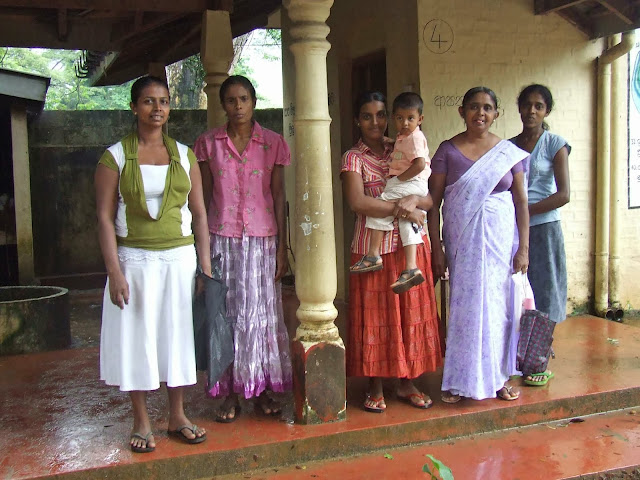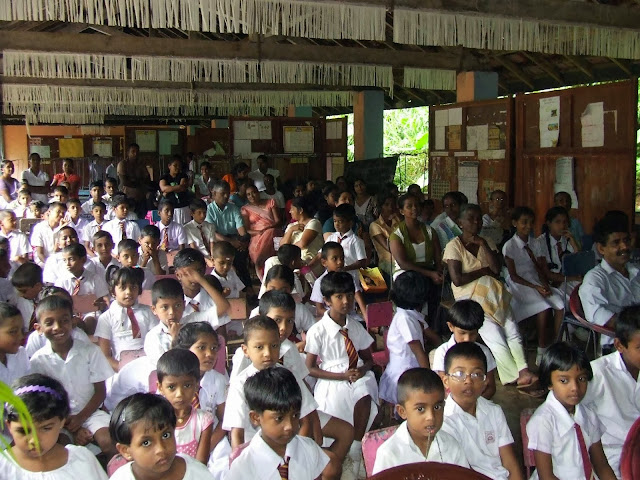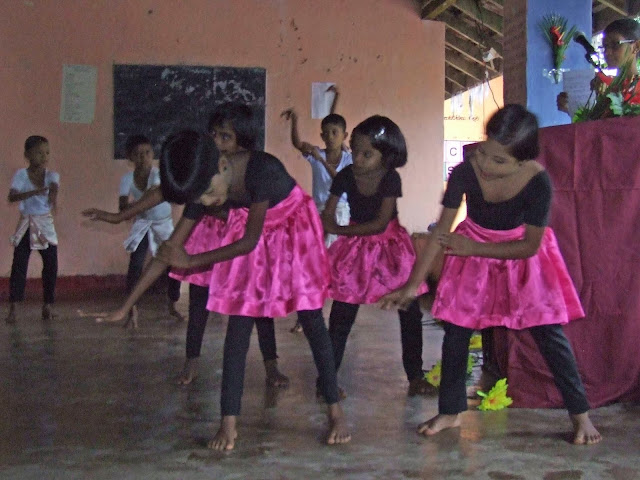Those who know me cannot avoid knowing of my passionate advocacy for better educational opportunities for those who find themselves on the lower rungs of the power base, be it in my own country or elsewhere in the world. [ In my own country I chose to teach in lower socio economic areas, often those where refugees and new immigrants found themselves. I loved it!] In particular I am most interested in assisting girls who are vulnerable to lives of poverty, domination, economic and social disadvantage, and the like. I believe that the highest possible standard of education is instrumental in ensuring that a girl has an enhanced opportunity for improved economic success, human rights , access to informed health care and knowledge and a whole lot more. Educate a girl and you educate the generations to come as well.
Beliefs and values are formed out of one's own experience of life and it is fair to say that getting an education was not as easy as it should have been for me. My difficulties provided me with a very real understanding of not only how important education is if you want to make huge changes in your life but also how very alone you can feel when what you want is not accepted by your family or actively obstructed. A little encouragement goes a very long way. In my case, the people who lifted me with a kind word had no idea of how much their comments or advice meant to me.
Of course, providing the best educational opportunities, support and encouragement for my own children was a top priority for me. This story, however, is not about my family. It is about my latest educational project in Sri Lanka.
"Project " is not the best word because it is a rather impersonal word and in this school, I have a very personal interest because the Principal is a niece who, having a not so easy life when young, received some encouragement and assistance from Sam, her Uncle not a lot older than her, when he himself was a university student. His faith in her has been proven wise as she now works tirelessly beyond her job description to inspire and enable her students to achieve an education mostly not known by their families.
Magammamana Kanista Vidyalaya is a small school of about one hundred and twenty students. It is located near two busy small towns, Karuwanwella and Ruwanwella, and the students are mostly the children of agricultural labourers and farmers in a rice growing pocket. The famous Kelaniya Ganga is nearby and this is where the Principal often finds her absent older boys when she goes out to search for them. No. They are not hanging out on a river bank having a free day off school. They are working, waist deep, or even diving to the bottom, to pull out buckets of river sand for a few rupees per bucket.
An intriguing aspect of the school is that, in British colonial days, the Administration building was the Karuwanwella Railway station! The old coach was apparently used as a classroom in the early days!
The staff and principal had made up the list of appropriate English books and they had been purchased, so one morning in the second week of term Sue, Sam and I braved the heavy rain, ensconsed in a bumpy tuk tuk for the hour long trip down our mountain and along a busy highway to the school. Our plan was to spend the day with the students and teachers, talking and reading some books I had carefully selected in Australia.
When we were ten minutes from the school we received a phone call asking how far away we were. I thought that big umbrellas would be at the ready to get us into school as dry as possible. Instead, we were greeted by a regal school band and all the students lined up their backs pressed to the wall to get out of the rain, some waving shyly.
Fortunately there was a brief enough pause in the rain for us to do as asked and parade behind the band, through the former train station foyer, across the courtyard and into a classroom where we were both presented with flowers by two of the youngest students, dressed in their traditional while national dress.
The room soon filled with students, teachers and parents who waited patiently while a couple of senior boys connected the speaker system to a car battery after a lightening bolt nearby knocked out the tenuous electricity.
Standing at the front of the room was the traditional lamp, ready for the lighting ceremony. This lamp, however, was not the traditional brass piece but a plant. I later learned that this and the flower decorations that created a festive air had been done by the parents of students.
Lighting the lamp always comes first for any important event in Sri Lanka. The flames which support life symbolise hope for the future, peace and prosperity.
Rituals beautifully and happily satisfied, we were then treated to a concert that was entertaining, inspiring, and simply delightful. The Principal and her staff sat back and let their students shine as they presented short plays, skits, songs - all in English as well as a selection of National dances. Three senior girls shyly but competently acted as Master of Ceremonies, dealing patiently with the temperamental sound system.
The younger children presented their dances first, accompanied by a small orchestra made up of traditional instruments.
These young girls bravely continued their story while the rain thundered on the roof and the sound system wavered, died and came to life again. As they left the stage a budding politician bounded onto the stage, confident of an attentive and suitably impressed audience!
What a great performance he delivered to his appreciative audience, one well used to visiting politicians!
Another entertaining act followed, a skit to the tune of "Clementine". It is essential for any Sri Lankan family that hopes for greatness to include at least one medical doctor and, as I watched this amusing skit, I hoped that at least one of these children would somehow get their chance to achieve this dream for their family. Later, one of the girls told me that she had that dream. Go, Girl!
It was then time for the senior girls to present their dances. Anticipation of a special performance was in the air and we learned that they had beaten every other school in the country at the recent Schools' National Dance competitions! An incredible feat, I think, knowing the resources and professional coaching enjoyed by very many schools in the main cities. This success has lifted their spirits and hopes for future successes, not only in Dance.
Lovely to see the rhythmic and graceful dancers enjoying their performance. They could easily replace the bored dancers who put on performances for tourists in Kandy.
Near the end of the program, Chandra, the Principal spoke, firstly in English and then in Sinhala. She talked about how kindness and educational assistance had changed her life and enabled her to assist them and now this was their chance, thanks to the interest and kindness of Zonta ladies in Australia. The Deputy Principal then spoke not only sending her heartfelt thanks and gratefulness to the Zonta ladies but also highlighting the fact that fluency in English is a prerequisite for a person to succeed in Sri Lanka. She was delighted that we had insisted that books bought be in English as they had only a few. It seems that the books supplied by the Education Department are primarily in Sinhala - understandable - and are Sri Lankan History, Geography, Buddhism. Now they have English novels, poetry and Science topic books.
We were then called up to present the books to the school, represented by the Principal, Deputy Principal and some students.
Of course, we also had to make a short speech! Fortunately we had an interpreter at the ready!
After the ceremony was over, we were treated to a lunch provided by the Staff and Parents and were able to discuss further specific needs. We had some money in reserve for needs other than books and I had thought that perhaps musical instruments or other teacher aids would be what was needed. Yes, they were needed but there was a greater need. Teachers were so very happy that they could now buy shoes, school bags and clothing for some families that could not send their children to school because they did not have these necessary items.
Day over, Sue and I felt very humbled at the way we had been received by the students, parents and teachers. Happy, too, that the students had enjoyed the chance to celebrate who they are and showcase their talents.
Drop a stone into a pond and see what happens.
Beliefs and values are formed out of one's own experience of life and it is fair to say that getting an education was not as easy as it should have been for me. My difficulties provided me with a very real understanding of not only how important education is if you want to make huge changes in your life but also how very alone you can feel when what you want is not accepted by your family or actively obstructed. A little encouragement goes a very long way. In my case, the people who lifted me with a kind word had no idea of how much their comments or advice meant to me.
Of course, providing the best educational opportunities, support and encouragement for my own children was a top priority for me. This story, however, is not about my family. It is about my latest educational project in Sri Lanka.
"Project " is not the best word because it is a rather impersonal word and in this school, I have a very personal interest because the Principal is a niece who, having a not so easy life when young, received some encouragement and assistance from Sam, her Uncle not a lot older than her, when he himself was a university student. His faith in her has been proven wise as she now works tirelessly beyond her job description to inspire and enable her students to achieve an education mostly not known by their families.
In 2012 I made a brief visit to this school, Magammana Kanista Vidyalaya, delivering some much appreciated Sports gear on behalf of a friend and a few books and posters I had left over from my donation to another village school that I felt was now well resourced. I noted the paucity of resource books, especially those in the English language and teaching aids - posters and the like. I also noted the enthusiasm of the students who wanted to practice their English and shyly but with quiet self confidence, initiated conversations with me. The brief conversations I had with a few of the teachers uplifted me. Here I found teachers who viewed their students, really poor village children, with great love, hope and dedication. Of course, I needed to find a way of helping and encouraging them in their inspirational belief that poor students, given appropriate support and encouragement, could achieve and lift themselves out of poverty!
Support was easily found! I am a member of a Zonta Club, an International service club of professional women with clubs all around the world. The mission of Zonta International and therefore of all Zontians, is to improve the legal, political, health, educational, and economic status of women worldwide. Most of our efforts are focused in our local and national communities, with a portion of our raised funds being sent to Zonta International to fund specific projects.
www.zonta.org
Some of the members in my club have personal connections, through volunteer service overseas or work in areas of Australia that have challenging needs, and our club supports these members in a variety of ways. In my case, I was offered a generous sum to support education for village children in my second home, Sri Lanka.
 |
| Magammamana Kanista Vidyalaya |
 |
| Village school, Sri Lanka |
An intriguing aspect of the school is that, in British colonial days, the Administration building was the Karuwanwella Railway station! The old coach was apparently used as a classroom in the early days!
 |
| Passenger coach, old Karuwanwella railway station |
When we were ten minutes from the school we received a phone call asking how far away we were. I thought that big umbrellas would be at the ready to get us into school as dry as possible. Instead, we were greeted by a regal school band and all the students lined up their backs pressed to the wall to get out of the rain, some waving shyly.
Fortunately there was a brief enough pause in the rain for us to do as asked and parade behind the band, through the former train station foyer, across the courtyard and into a classroom where we were both presented with flowers by two of the youngest students, dressed in their traditional while national dress.
 |
| Magammana Kanista Vidyalaya Band |
Standing at the front of the room was the traditional lamp, ready for the lighting ceremony. This lamp, however, was not the traditional brass piece but a plant. I later learned that this and the flower decorations that created a festive air had been done by the parents of students.
 |
| Lighting the lamp |
Rituals beautifully and happily satisfied, we were then treated to a concert that was entertaining, inspiring, and simply delightful. The Principal and her staff sat back and let their students shine as they presented short plays, skits, songs - all in English as well as a selection of National dances. Three senior girls shyly but competently acted as Master of Ceremonies, dealing patiently with the temperamental sound system.
The younger children presented their dances first, accompanied by a small orchestra made up of traditional instruments.
 |
| School orchestra |
These young girls bravely continued their story while the rain thundered on the roof and the sound system wavered, died and came to life again. As they left the stage a budding politician bounded onto the stage, confident of an attentive and suitably impressed audience!
 |
| Politician in training! |
Another entertaining act followed, a skit to the tune of "Clementine". It is essential for any Sri Lankan family that hopes for greatness to include at least one medical doctor and, as I watched this amusing skit, I hoped that at least one of these children would somehow get their chance to achieve this dream for their family. Later, one of the girls told me that she had that dream. Go, Girl!
 |
| Too many Peanuts, too many peanuts! |
Lovely to see the rhythmic and graceful dancers enjoying their performance. They could easily replace the bored dancers who put on performances for tourists in Kandy.
Near the end of the program, Chandra, the Principal spoke, firstly in English and then in Sinhala. She talked about how kindness and educational assistance had changed her life and enabled her to assist them and now this was their chance, thanks to the interest and kindness of Zonta ladies in Australia. The Deputy Principal then spoke not only sending her heartfelt thanks and gratefulness to the Zonta ladies but also highlighting the fact that fluency in English is a prerequisite for a person to succeed in Sri Lanka. She was delighted that we had insisted that books bought be in English as they had only a few. It seems that the books supplied by the Education Department are primarily in Sinhala - understandable - and are Sri Lankan History, Geography, Buddhism. Now they have English novels, poetry and Science topic books.
We were then called up to present the books to the school, represented by the Principal, Deputy Principal and some students.
Of course, we also had to make a short speech! Fortunately we had an interpreter at the ready!
 |
| Parents who want a better education for their children |
 |
| Staff of Magammana Kanista Vidyalaya |
Day over, Sue and I felt very humbled at the way we had been received by the students, parents and teachers. Happy, too, that the students had enjoyed the chance to celebrate who they are and showcase their talents.
Drop a stone into a pond and see what happens.










































